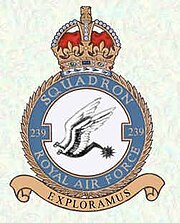| No. 239 Squadron RAF | |
|---|---|
 Official squadron badge for No. 239 Squadron RAF Official squadron badge for No. 239 Squadron RAF | |
| Active | 20 August 1918 – 31 May 1919 18 September 1940 – 1 July 1945 |
| Country | |
| Branch | |
| Motto(s) | Latin: Exploramus ("We seek out") |
| Insignia | |
| Squadron Badge heraldry | A winged spur This was the first squadron to work with an armoured division, which included mechanised cavalry, with which the spur provided association |
| Squadron Codes | HB (Sep 1940 – Sep 1943 and Jan 1945 – Jul 1945) |
No. 239 Squadron RAF was an anti-submarine squadron of the Royal Air Force during World War I. During World War II the squadron performed as an army co-operation squadron and later as a night intruder unit. After the war the squadron was disbanded.
History
Formation and World War I
No. 239 Squadron RAF was formed from No 418 (Coastal reconnaissance) Flight at Torquay, on 20 August 1918, and was equipped with the Short 184, flying anti-submarine patrols with them until the Armistice. The squadron either disbanded on 15 May 1919 or on 31 May 1919
World War II
On 18 September 1940, the squadron reformed at RAF Hatfield from a flight each of No. 16 and No. 225 squadrons. The squadron began with Westland Lysanders, and then later re-equipped with Curtiss Tomahawks and Hawker Hurricanes. The squadron converted to North American P-51 Mustangs in May 1942 and began ground attack and reconnaissance operations over Northern France, which lasted till August 1943, the squadron also taking part in the air cover during the Dieppe Raid.
In September 1943 the squadron moved to RAF Ayr to train as a night fighter unit, and re-equipped with the de Havilland Mosquito. It then moved to RAF West Raynham to join No. 100 (Bomber Support) Group, participating in night time operations against enemy fighters. On 27 October 1944 during fighter affiliation training with No. 49 Squadron RAF, a Mosquito piloted by F/Lt J.H.Roberts and accompanied by Flight Engineer Sgt. A.M.Ashcroft, stalled and crashed in Stapleford Woods, Lincolnshire, with the immediate death of both pilot and passenger.
The squadron disbanded on 1 July 1945.
Aircraft operated
| From | To | Aircraft | Variant |
|---|---|---|---|
| Aug 1918 | May 1919 | Short 184 | |
| Sep 1940 | Mar 1941 | Westland Lysander | Mk.II |
| Mar 1941 | Jan 1942 | Westland Lysander | Mk.IIIa |
| Jun 1941 | May 1942 | Curtiss Tomahawk | Mks.I & IIa |
| Jan 1942 | May 1942 | Hawker Hurricane | Mks.I & IIc |
| Jun 1942 | Dec 1942 | Fairey Battle | Mk.II |
| Mar 1942 | Jul 1942 | Miles Master | Mks.I & III |
| May 1942 | Sep 1943 | North American Mustang | Mk.I |
| Oct 1943 | Jan 1944 | Bristol Beaufighter | Mk.If |
| Dec 1943 | Sep 1944 | de Havilland Mosquito | Mk.II |
| Sep 1944 | Jan 1945 | de Havilland Mosquito | Mk.VI |
| Jan 1945 | Jul 1945 | de Havilland Mosquito | NF.30 |
References
Citations
- ^ Rawlings 1978, pp. 341–342.
- ^ Rawlings 1982, pp. 172–173.
- ^ Halley 1988, pp. 306–307.
- Bowyer and Rawlings 1979, p. 49.
- Flintham and Thomas 2003, p. 77.
- ^ Jefford 2001, p. 78.
- "No. 49 Squadron RAF". The 49 Squadron Association. Retrieved 9 August 2012.
Bibliography
- Bowyer, Michael J.F. and John D.R. Rawlings. Squadron Codes, 1937–56. Cambridge, UK: Patrick Stephens Ltd., 1979. ISBN 0-85059-364-6.
- Flintham, Vic and Andrew Thomas. Combat Codes: A full explanation and listing of British, Commonwealth and Allied air force unit codes since 1938. Shrewsbury, Shropshire, UK: Airlife Publishing Ltd., 2003. ISBN 1-84037-281-8.
- Halley, James J. The Squadrons of the Royal Air Force & Commonwealth 1918–1988. Tonbridge, Kent, UK: Air Britain (Historians) Ltd., 1988. ISBN 0-85130-164-9.
- Jefford, C.G. RAF Squadrons, a Comprehensive record of the Movement and Equipment of all RAF Squadrons and their Antecedents since 1912. Shrewsbury, Shropshire, UK: Airlife Publishing, 1988 (second edition 2001). ISBN 1-85310-053-6.
External links
| Royal Air Force | |||||||
|---|---|---|---|---|---|---|---|
| Ministry of Defence | |||||||
| formations and units |
| ||||||
| branches and components | |||||||
| reserve forces | |||||||
| equipment | |||||||
| personnel | |||||||
| appointments | |||||||
| symbols and uniform | |||||||
| associated civil organisations | |||||||